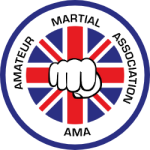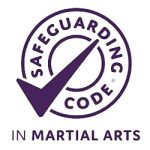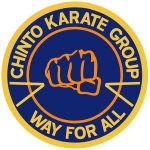Once you've taken that initial, nervous step into the hall, the first thing you can expect is a warm welcome from everyone.
Tracy. our Head Coach, will find out if you have done any training before and if you have any restriction, physical limits or special needs. After that she will appoint a 'Buddy' to help you fit into the class. You're welcome to just watch for the first session, but you will be encouraged to join in and line up with the other students..
what to bring
All that is needed is loose fitting clothing and a willingness to try. We don't recommend eating a heavy meal before you come as some of the activities can be quite strenuous and a full stomach might be uncomfortable.
We normally train in bare feet, but some people prefer to wear very light sports shoes. Socks are not recommended because of their tendency to slip on the floor and heavier shoes, such as trainers, may hurt others during sparing.
A bottle of water is a good idea to help keep you hydrated, especially in the warmer months.
what does it cost
There is no membership or joining fee and the first session is free. After that you pay just £4 per session and cash is preferred.
After a few weeks you may wish to purchase a Karate gi (Karate suit) at this point you will wear a white belt. As you progress you will be given the opportunity to attend regular gradings so you can measure, and demonstrate, your progress in karate. There is an administration charge for the grading and this includes a new coloured belt. More details of the various grades and how to progress can be found below.
There is a minimal insurance cost, payable at your first grading and annually thereafter.
Over time you may want to buy additional equipment such as sparing gloves, shin pads, foot protectors and a gum shield. However these are all optional and the purchase can be spread over many months.
You are welcome to order these through the Head Coach or you can purchase them directly from your chosen supplier.
what happens during a session
All our classes are 55 minutes long and are designed to ensure personal development.
They will all start with a 5-10 minute warm-up and stretching session and will also end with a short 'cool down' stretch. This minimises the risk of muscle injury. During the junior sessions, this may involve games and fun activities, however these will all be designed to support the needs of the class and encourage involvement. We do not play games just for the sake of fun, they will all have a structure (except maybe at Christmas when no one is looking}.
Our sole aim is to aim to bring out the best in our students.
The main part of the session will be dedicated to training in Shukokai Karate or, in some cases, Kobudo.
The training will be structured and will change from session to session to ensure the student gets a good grounding in the three main elements of : Kihon (basic techniques), Kata (set sequences of techniques) and Kumite (sparring). Each section has a range of complexity to suit the different skill levels or grades of students. .
WHAT IS SHUKOKAI KARATE?
Our style of Karate is known as Shukokai (pronounced Shu-Ko-Kai) and was founded in 1946 by Chojiro Tani. You can find out more about this and general the history of karate by visiting our 'History' page.
Roughly translated Shukokai means “Way For All” and this reflects how the style has developed, although it keeps its purity. The style is very fast using a relatively high stance to aid mobility. The Martial Arts Commission of Great Britain has also stated in its Official Handbook that “Shukokai punches are the strongest to be found in Karate”.
The style stresses controlled contact in competition sparring. However, real experience of full-power techniques is enabled by the use of pad work. Shukokai, as taught by Chojiro Tani, had a distinctive double hip twist creating a motion that ensured that punches were delivered using the big muscles of the upper leg and with body rotation. Shigeru Kimura was not happy that this produced the fastest or strongest technique and spent many years studying and refining his techniques, before introducing them to the UK. These techniques also stressed rotation, utilising the strongest muscles but was also faster, saving time by having the body already rotated in the ready stance.
Therefore Shukokai Karate is one of the most dynamic of all the Karate styles.
kihon
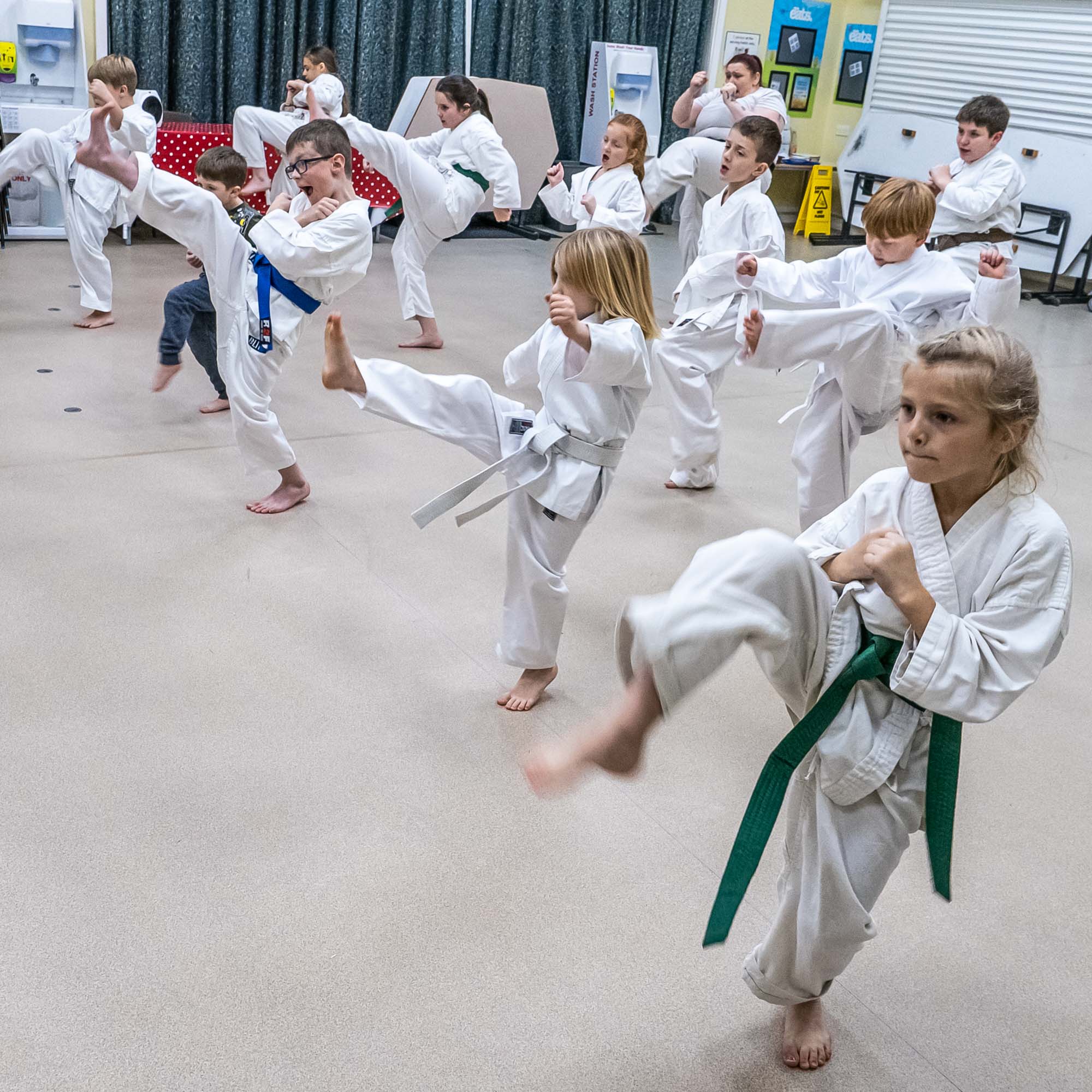
Kihon (基本, きほん) is a Japanese term meaning "basics" or "fundamentals." The term is used to refer to the basic techniques that are taught and practiced as the foundation of most Japanese martial arts.
The practice and mastery of kihon is essential to all advanced training, and includes the practice of correct body form and breathing, while practicing basics such as stances, punches, kicks, blocks, and thrusts, but it also includes basic representative kata.
Kihon is not only practicing of techniques, it is also the budōka fostering the correct spirit and attitude at all times. Kihon techniques tend to be practiced often, in many cases during each practice session. They are considered fundamental to mastery and improvement of all movements of greater complexity.
kata
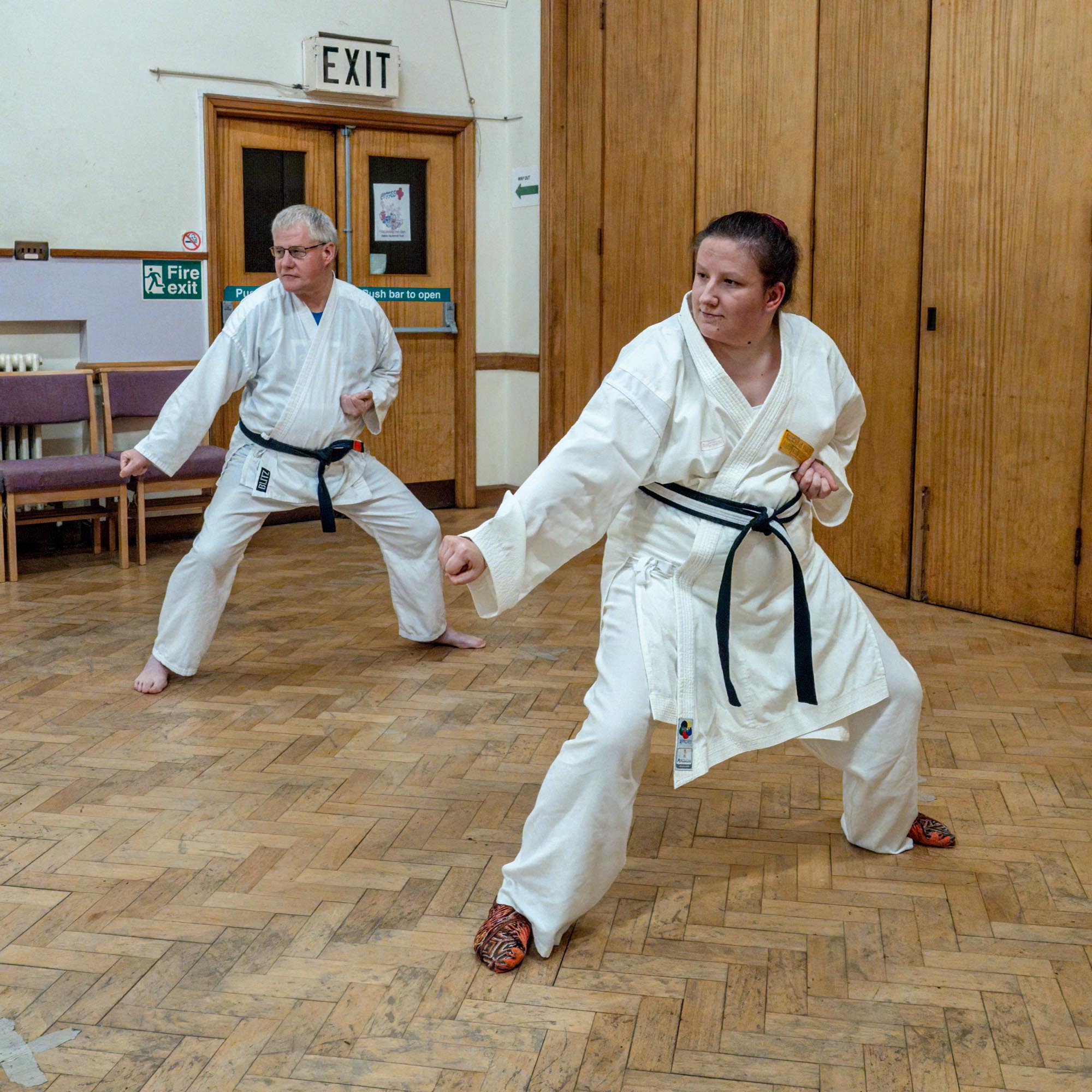
Kata is a Japanese word (型 or 形) meaning "form". It refers to a detailed choreographed pattern of martial arts movements made to be practised alone.
It can also be reviewed within groups and in unison when training. It is practised in Japanese martial arts as a way to memorise and perfect the movements being executed.
In the early days of Karate a Kata could take may years to master and was almost seen as a 'one stop shop' for self defence. The Kata was designed to create an 'autopilot' sequence of moves to protect against different attacks. These attacks are referred to as Bunkai and can be demonstrated, along with the corresponding kata, at competitions.
Kata are also used in many traditional Japanese arts such as theatre forms like kabuki and schools of tea ceremony (chadō), but are most commonly known in the martial arts.
Kata are used by most Japanese and Okinawan martial arts, such as Aikido, Judo, Kendo, Kenpo, and Karate.
Karate Kata made its Olympic debut, as a sport, in 2020
kumite

Kumite will be introduced to you as basic blocking and counter attacking, but will ultimately lead you to freestyle fighting, where you will be taught to attack with and defend against, unannounced attacks.
Kumite (Japanese: 組手, literally "grappling hands") is one of the three main sections of karate training, along with kata and kihon. Kumite is the part of karate in which a person trains against an adversary.
Kumite can be used to develop a particular technique or a skill (e.g. effectively judging and adjusting one's distance from one's opponent) or it can be done in competition.
Kumite is often referred to as sparring and involves a degree of contact with your opponent. Hence, control is a key element that is taught. Protective gear is often worn during Kumite training.
Karate Kumite made its Olympic debut, as a sport, in 2020
.
DISCIPLINE AND RESPECT
The Dojo is used to describe the training area. Sometimes it applies to a building or a room. In some cases this is a purpose built facility, in others a rented hall in a school or community centre. Sometimes it can even be outside. Regardless of the actual location the Dojo should just be considered as space of focus, commitment, learning and training and should be treated with respect.
When entering or leaving the Dojo a Karateka (student of karate) is asked to bow (Rei). This is done as a sign of respect for the place where karate learning is fostered and in which you will be learning karate yourself. It is also done as a sign of respect to the other karateka who are already inside and will be training with you. This bow is done both when entering and when leaving the dojo as a sign of respect for the learning and training that takes place inside. The respect shown to the Dojo should not end with the bow. It is expected that you as a karateka show respect to the dojo not only by bowing, but through your other actions as well. The bow isn't just a 'bit of tradition', it is about recognising respect for the sanctity of the dojo and gratitude for the learning and self-refinement as well as a reminder to be humble before you train.
Discipline in the dojo or training hall is of paramount importance, to ensure that it's a productive learning space and also for the safety of student. Failure to follow instructions could lead to a misunderstanding that could cause an injury.
Dojo etiquette is a code of conduct essential to the proper practice of martial arts. It is important to understand the values of respect and discipline, without this understanding, practice becomes meaningless.
Please read the following:
On entering and leaving the training area always bow
Swearing in the training area will not be tolerated at any time
Students must keep their bodies and karate gi clean.
Nails must be cut.
No jewellery is permitted to be worn during training
No talking is permitted during training unless absolutely necessary
Students must make every effort to attend class on time. Anyone who is late must execute a bow, to the Coach, and wait for the instructors acknowledgement before joining the class
Never lean against the walls or sprawl out across the floor.
Never stand with your hands on your hips or arms crossed
When asked to line out or called upon by an instructor, you are always to move into position as quickly as possible
Any student wishing to leave the training area shall not do so until he or she receives the instructors permission
Occasionally a Senior Kyu Grade may lead the class, during warm-up. They are to be afforded the same respect as the Coaches.
When training with a partner both shall bow to each other before and after each session
Students shall do their utmost to carry out training as laid down by the instructor
Understand these dojo/training rules
Above all else, have fun and enjoy your training
gradings and ranks
Explanation about gradings.
how often how they're structured, what to expect.

Shoshinsha (初心者)
white belt
The white belt (obi) symbolises a birth or beginning of a person’s will to acquire the skills of karate, and it is worn by those who are just beginning their study. A white belt symbolises the starting point or the beginning of the Karate journey. Individuals, new to Karate, don't yet know how to control their minds or bodies, so their white belt is a representation of both their pure nature as well as their commitment and determination to learn and grown through Karate. White has always been the symbol of purity. This is quite suiting, as those who begin in the art of karate are innocent and unknowing to the work and discipline required of them to achieve mastery of the art. This is the beginning of a voyage from innocence to mastery, and this level introduces the first ideas of karate.

Hakkyū 八級
Yellow Belt
Yellow signifies the first beams of sunlight that give a seedling new growth and new life. As such, the yellow belt is worn by a beginner who has learned to practice the basic principles of karate.
Once a student has a yellow belt, he/she has advanced from the introductory level. He has now transformed from a pure novice to developing a basic understanding in the art of karate. The yellow belt is representative of one’s energy. In this mastery, the student has gained greater control over his body’s energy.
Training requirement: Minimum 3 months training from last grading
Basics :
(Kamae) as 9th kyu Blocks Jodan Uke
Combinations :
1, 2
Kicks :
Mae Geri, Mawashi Geri
Kata :
Shihozuki (cross kata)
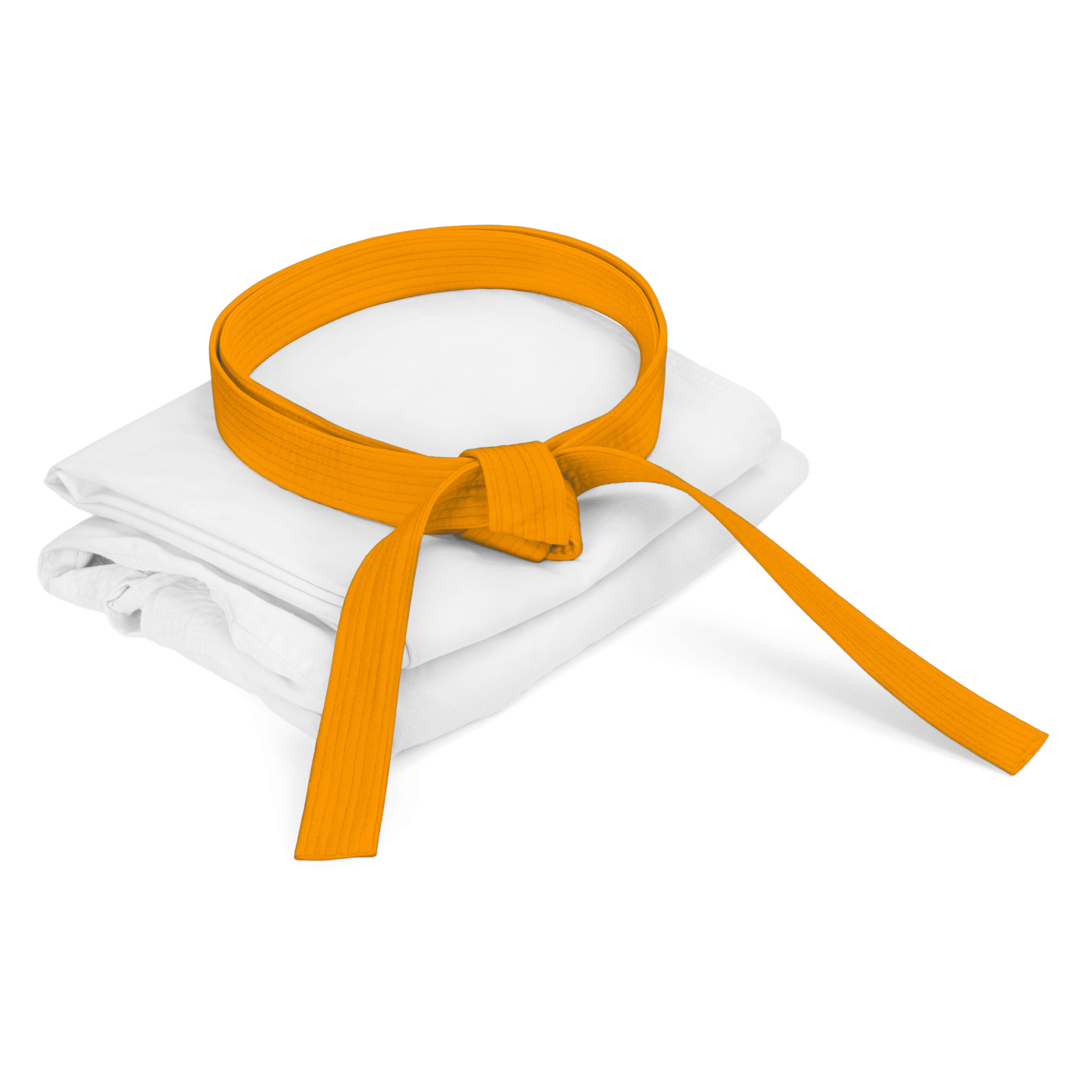
Nanakyū 七級
orange belt
Orange represents the growing strength of the sun, so the orange belt is given to a beginner once they have mastered karate’s basic moves.
Stability is the symbol of an orange belt. Karate practice includes basic postures, punches, blocks and kicks. The white, yellow, and orange belts are the basic principal building blocks, and all other methods learned in higher belts are built upon these basic skills.
Training requirement: Minimum 3 months training from last grading
Basics :
(Kamae) as 8th kyu plus Maeken Zuki Blocks Jodan Uke, Shuto Uke
Combinations :
1, 2, 3
Kicks :
Mae Geri, Mawashi Geri
Kata :
Ginino (H Kata)
Impact :
Oi Zuki, Gyaku Zuki, Mae Geri.
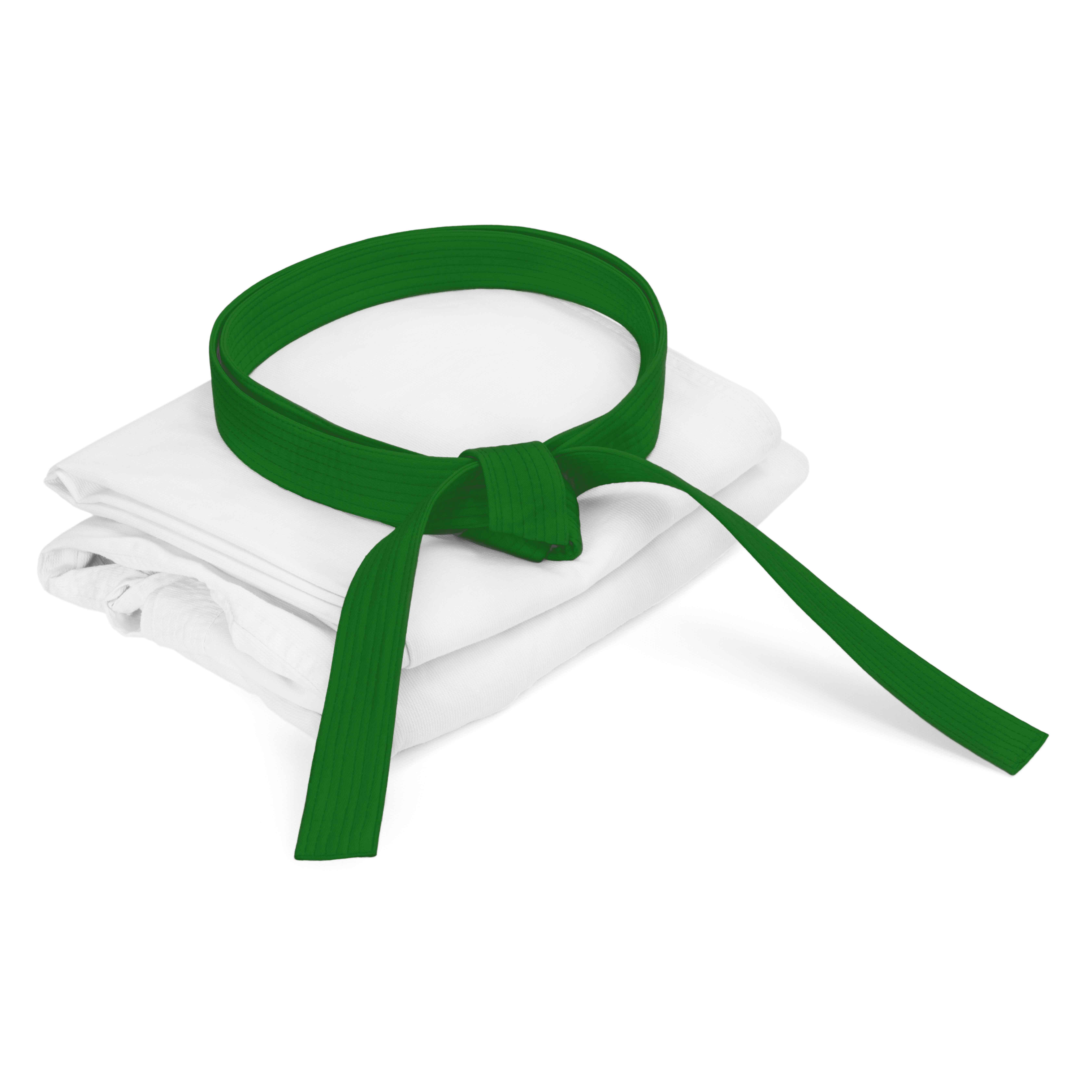
Rokkyū 六級
green belt
Green is a representation of growth, so it is given to intermediate students who are learning to strengthen and refine their skills.
When a student has achieved green belt status, this student have advanced from the beginner level to the intermediate level. Students at this belt color should understand all standard blocks and strikes, while also knowing how to contort and move their body to achieve the desired block or strike.
Training requirement: Minimum 3 months training from last grading
Basics :
(Kamae) as 7th kyu Blocks Jodan Uke, Shuto Uke
Combinations :
3, 4, 5
Kicks :
Mae Geri, Mawashi Geri
Kata :
Pinan Nidan
Impact :
Gyaku Zuki, Maeken Zuki, Mae Geri, Mawashi Geri.

Gokyū 五級
blue belt
Blue represents the sky and the light it provides all growing things, so the blue belt is given to students at the stage of their studies when they begin to learn additional knowledge of the martial art that allows their minds and bodies to continue to grow and develop.
Once the basic skills of the white, yellow, orange, and green belts have been mastered, the student must learn to become more adaptable to given situations. The purpose of the blue belt is to reflect that the student has demonstrated fluidity and adaptability. With fluidity comes greater strength and confidence.
Training requirement: Minimum 4 months training from last grading
Basics :
(Kamae) as 6th kyu plus Sekkyaku Zuki Blocks Shuto Uke, Soto Uke
Combinations :
4, 5, 6
Kicks :
Mae Geri, Mawashi Geri, Yoko Geri
Kata :
Pinan Sandan
Impact :
As 6th Kyu plus Oi Zuki
Effective Sparring

Yonkyū 四級
purple belt
Purple represents the colours of dawn, so a purple belt is given to a student who is transitioning into the advanced stages of study.
The purple belt is the belt where students become humbled and dedicated as training becomes harder and more serious. With this transition comes a great flow of emotion and sensitivity.
Training requirement: Minimum 3 months training from last grading
Basics :
(Kamae) as 5th kyu plus Ashi Barai Blocks Shuto Uke, Uchi Uke
Combinations :
5, 6, 7
Kicks :
As 5th Kyu
Kata :
Pinan Shodan, plus any previous Kata
Impact :
Oi Zuki, Gyaku Zuki, Sekkyaku Zuki, Mae Geri, Mawashi Geri, Yoko Geri
Effective Sparring

Sankyū 三級
brown belt
Brown is a representation of the ripening of a seed during the maturing and harvesting process, so a brown belt is awarded to advanced students who are beginning to realise the fruits of their beginner studies and whose techniques have begun to mature.
When a student achieves his/her brown belt, this is the introduction to the advanced level of martial arts. This belt symbolises that the student is experienced and knowledgeable in the art that they are studying.
Training requirement: Minimum 6 months training from last grading
Basics:
(Kamae) Oi Zuki, Gyaku Zuki, Maeken Zuki, Uraken Uchi, Ashi Barai Blocks Gedan Barai, Jodan Uke, Shuto Uke
Combinations :
6, 7, 8
Kicks :
Mae Geri, Mawashi Geri, Ushiro Geri
Kata :
Pinan Yondan, plus any previous Kata
Impact :
As 4th Kyu plus Maeken Zuki, Gedan Barai, Gyaku Zuki, Ashi Barai
Effective Sparring

Nikyū 二級
brown and red belt
The addition of the red stripe signifies the depth of the knowledge that a student possesses and ability to give those a successful direction.
Those who reach brown and red belts are nearing at mastery. Students are required to be both practical and creative in their techniques. Confidence sets in as one’s own personality is integrated with the many techniques they have already mastered.
Training requirement: Minimum 6 months training from last grading
Basics :
(Kamae) Oi Zuki, Gyaku Zuki, Sekkyaku Zuki, Uraken Uchi, Ashi Barai Blocks Gedan Barai, Jodan Uke, Soto Uke
Combinations :
7, 8, 9
Kicks :
As 3rd Kyu plus Yoko Geri
Kata :
Pinan Godan, Jerokono, plus any previous Katas
Impact :
As 3rd Kyu plus Ushiro Geri. Substitute Jodan Uke for Gedan Barai
Effective Sparring
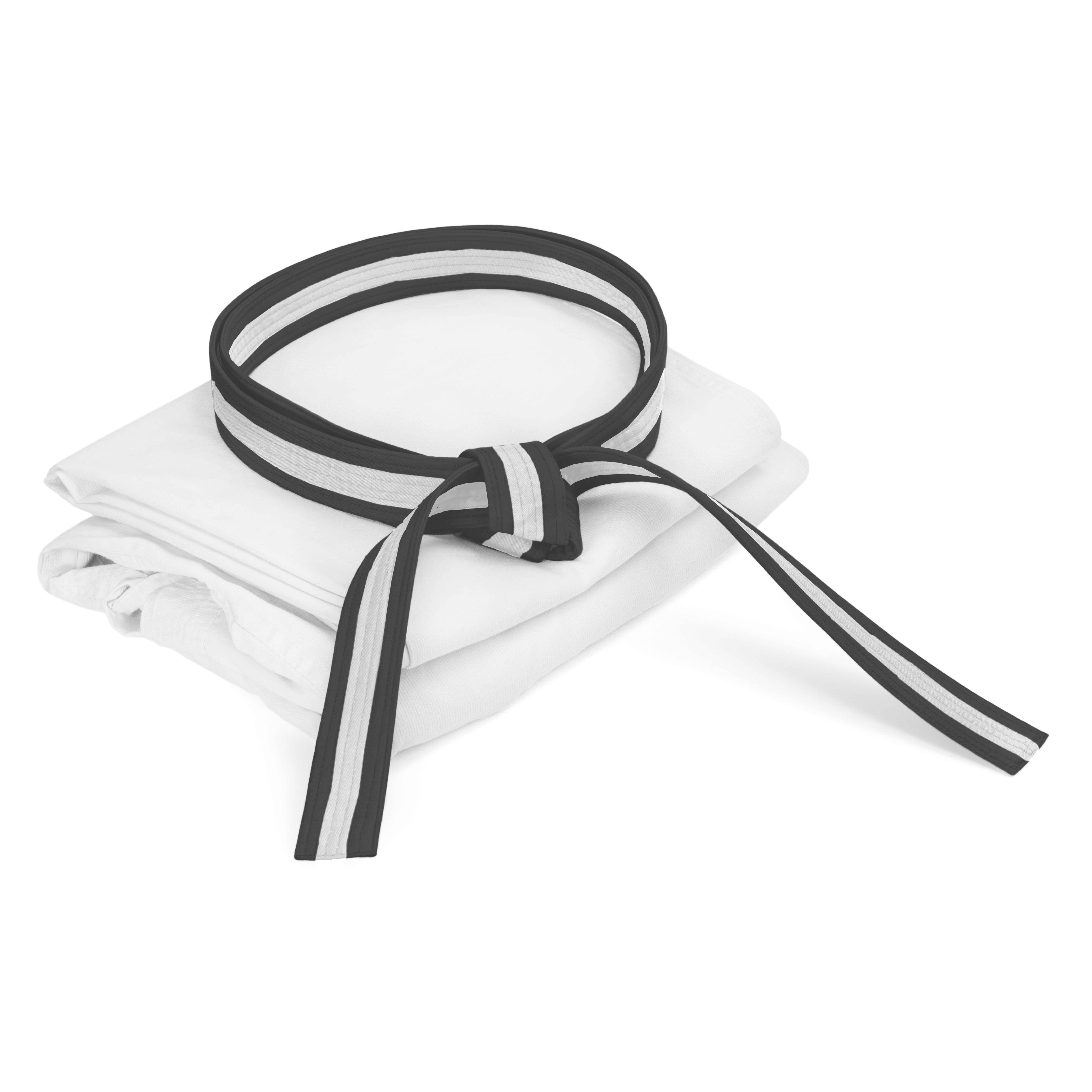
Ikkyū 一級
black and white belt
Training requirement: Minimum 6 months training from last grading
Basics :
(Kamae) as 2nd Kyu plus Maeken Zuki Blocks Shuto Uke, Soto Uke, Uchi Uke
Combinations :
8, 9, 10
Kicks :
As 2nd Kyu
Kata :
Matsukasi, Annanku, plus any previous Katas
Impact :
As 2nd Kyu plus Uraken Uchi, Ushiro Mawashi Geri. Substitute Shuto Uke for Jodan Uke
Effective Sparring
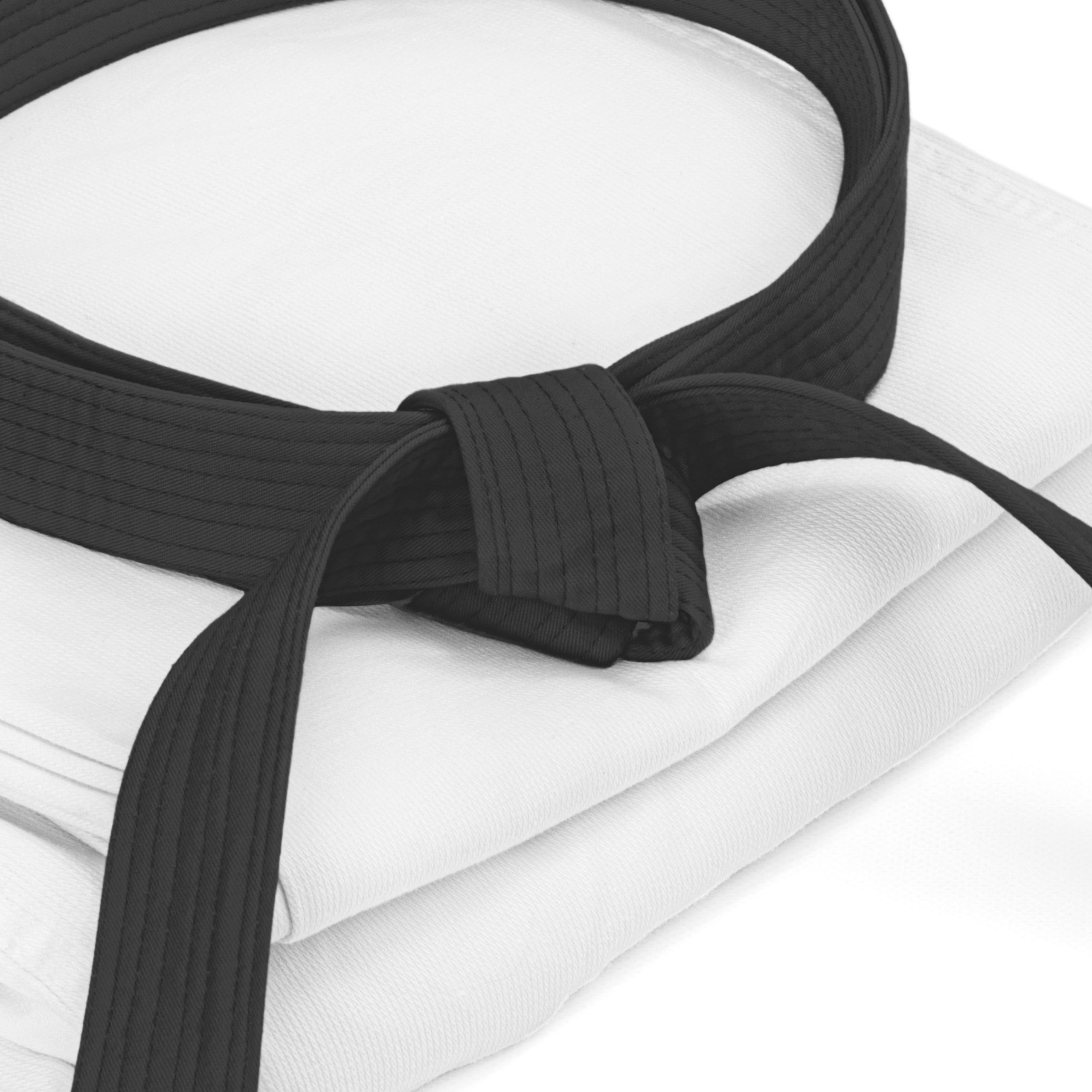
Once a person has completed the Kyu grades they may then feel ready to progress to the next level; the Dan grades. These are designated by 'bars' added to a black belt. Most people, even those who don’t practice karate, know or have heard the term “black belt”. Unfortunately, few really know what it really represents.
It is not the final level, it is not the end, and it is not the pinnacle of achievement. Instead, it is a brand new beginning and practitioners, that have reached this level, have now learned the basics and are ready to venture out into the world and find ways to further grow.
.

black with one red bar
Every glowing object has a dark shadow behind it and black symbolises the darkness beyond the sun, and a person who has been awarded a black belt has demonstrated that they have mastered all the basic skills and posses an ability to enlighten others with that knowledge.
They have start their journey to gain a deeper and further understanding of the physical and mental teachings of karate.

BLACK WITH one red and one white BAR
This is mid-level dan grade aimed and helping to maintain motivation and assist with progress.

BLACK WITH two red BARS
Training requirement: Minimum 2 years training from Shodan grading.

BLACK WITH TWO RED BARS and one white
This is mid-level dan grade aimed and helping to maintain motivation and assist with progress.

BLACK WITH three RED BARS
Training requirement: Minimum 3 years training from Nidan grading

BLACK WITH three RED BARS and one white
This is mid-level dan grade aimed and helping to maintain motivation and assist with progress.
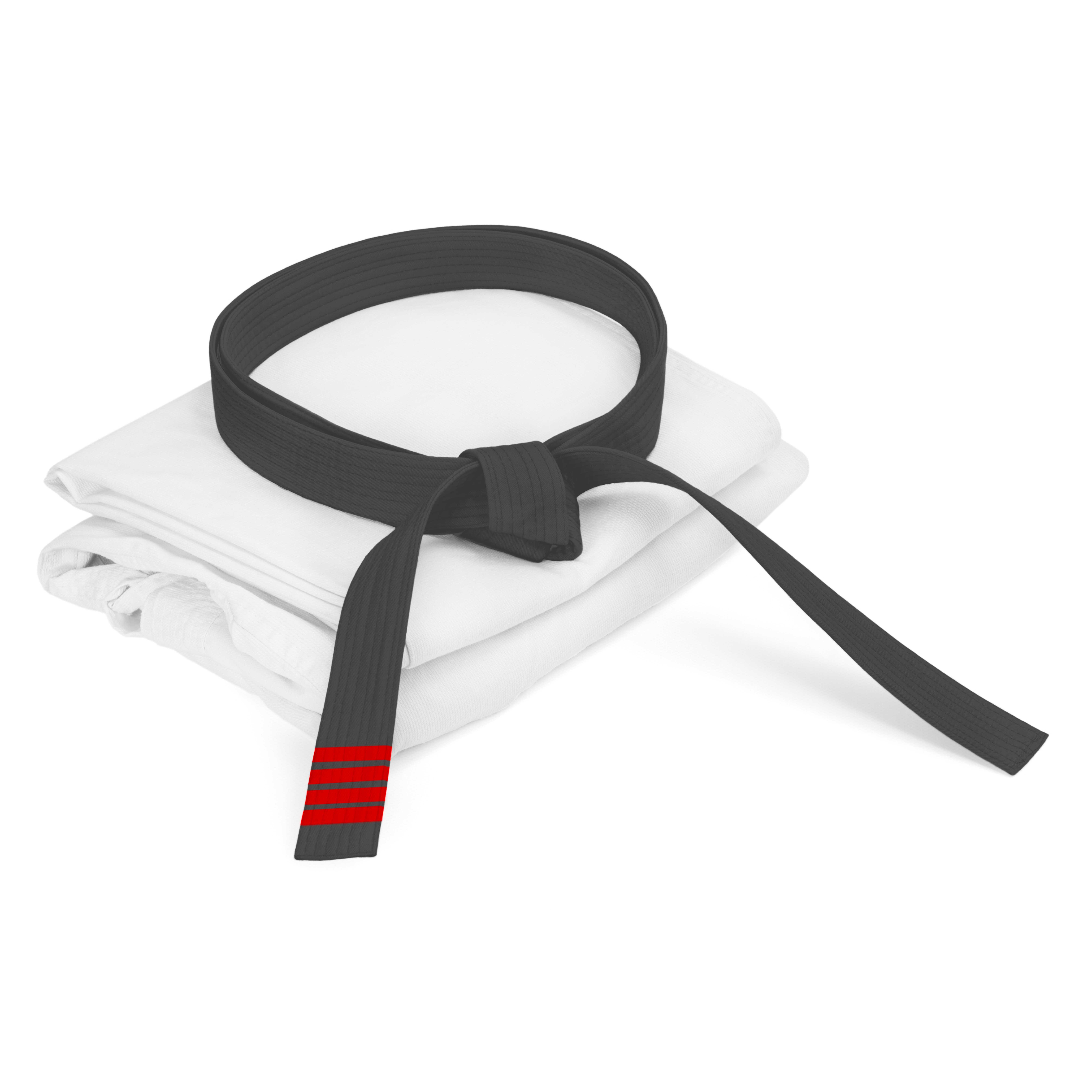
BLACK WITH four RED BARS
Training requirement: Minimum 4 years training from Sandan grading .
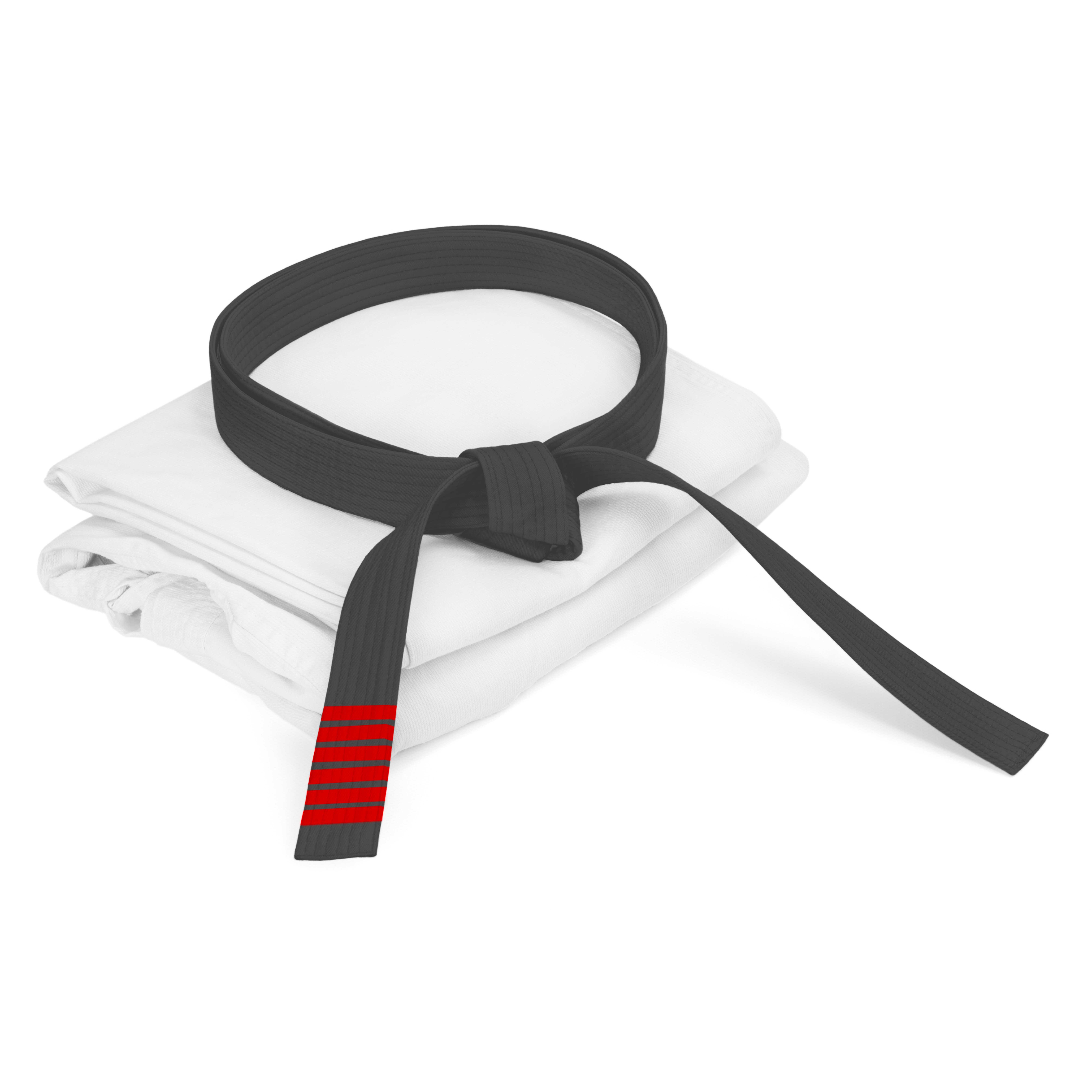
BLACK WITH five RED BARS
Training requirement: Minimum 5 years training from award of Yondan

BLACK WITH six RED BARS
Training requirement: Minimum 6 years training from award of Godan

